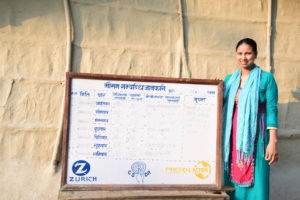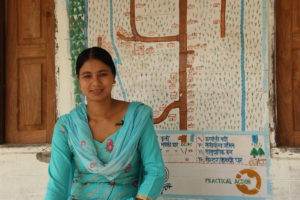Karuna Chaudhary is 29 and lives in the far west of Nepal in an area at high risk of flooding. In her role as Chairperson of the local Community Disaster Management Committee, she works with Practical Action to help those around her predict floods and landslides.
Working together to withstand floods
“I’m respected as a leader by my local community,” Karuna told us, “I’m thankful to have this opportunity to help people in the area. The villagers trust me – and I am repaying their trust.”
Karuna was born into poverty, but through her determination and ambition has worked her way up to become a successful leader and an inspiration to others. The Community Disaster Management Committees, set up with support from Practical Action, have given influential local people like Karuna new opportunities to make a difference.

This weather board in the centre of the community is one way Karuna lets others know about predicted weather and river water levels.
“I studied up to high school,” said Karuna. “As there were not many other people in the village who can read and write, people would come to me looking for help. And I would happily oblige. People started looking up to me as a leader. That’s how I was chosen to work with Practical Action in the position of Committee Chairperson. I’m proud to represent my community and help solve the problems we face together.”

Maps and action plans mean that Karuna’s community know which areas are most at risk and where to evacuate to in an emergency.
An Alliance against flooding
Floods affect more people globally than any other type of natural hazard. They cause some of the largest economic, social and humanitarian losses, involving on average some 250 million people each year. The poorest communities suffer most as repeated disasters undermine their potential to develop and trap them in a cycle of poverty. Flood risk is increasing as poor development, erratic rainfall patterns and unsustainable land use practices put more people in harm’s way.
For six years we’ve been part of the Zurich Flood Resilience Alliance. This brings together risk expertise from the private sector and from research, humanitarian and development organisations. Its aim is to reduce risk and improve the livelihoods of vulnerable communities. Our main role in the Alliance is as a developer and sharer of practical, tried-and-tested knowledge – something that’s allowing us to share best practice with flood-prone communities around the world.
People have been supported to build low-cost monitoring stations, which send out SMS alerts warning communities about impending floods. It gives them extra time to protect their property and possessions.
They’ve also learned to adapt their farming methods and have put together evacuation plans, which further helps them prepare. Meanwhile, the flood resilient shelters we’ve built together and their new food distribution processes are helping them bounce back after floods.
Our expertise has already influenced national adaptation plans and climate change policies. Through our engagement with influencing groups, we’ve even helped shape the processes of the United Nations Framework Convention on Climate Change in the areas of climate technology and loss and damage. By sharing practical experiences of the poor communities in which we work, we have helped to consolidate knowledge and influence policy. Something that continues to be at the top of our agenda in our engagement with the Alliance.
Powerful partnerships
The climate crisis is creating a whole new set of challenges when it comes to resilience.
Disasters are becoming worse and happening more often – accelerating the need to find solutions to problems that have existed for years but are getting rapidly worse. Despite this, it’s hard to persuade governments to invest in risk reduction. That’s why we’re continuing to work with powerful partners to make the case that disaster resilience and therefore reducing the negative impact of floods and other natural hazards for the poorest who are often left behind.